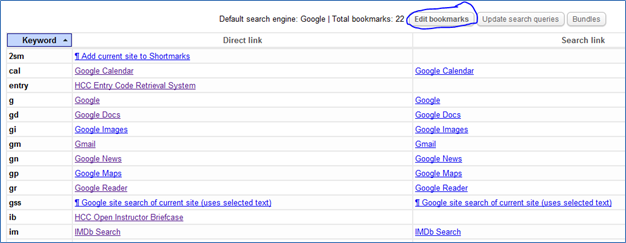Shortmarks: Shortened Bookmarks
Web browsers have gotten smarter. Enter a few letters and the browser flips through your browsing history to find matches. Want to go even faster? Check out Shortmarks. When I type gm into my web browser’s address bar and hit enter, Google Mail opens. When I type im Jodie foster, my browser automatically searches IMDB for Jodie Foster.
Shortmarks starts you off with a bunch of shortcuts. Here are some. Most of these were already provided by Shortmarks. The keyword is in the first column. Typing this in your browser’s address bar will open the site it’s attached to. If you don’t like the keyword, you can change it. Click on “Edit bookmarks.”

That calls up the edit page. When I type cal in my browser’s address bar, Google calendar opens. But I can change that just by clicking in that keyword box and typing something else.

Adding new shortmarks.
One way to add a new shortmark is to go to the Shortmarks edit page, enter the keyword you’d like to use, name the page, and enter the link to the page. Click save. Done.
A quicker way is to go to the Shortmarks help page, and drag the “Add to Shortmarks” link to your browser’s bookmark bar. Now visit any page you’d like to create a shortmark for. Click “Add to Shortmarks” on your browser’s bookmark bar. The Shortmarks edit page will open with the name of the page and the URL already entered. Just enter the keyword you’d like to use, and click save. Done.
Searching websites.
Notice the far right shortmarks column; it’s labeled “Search link” (see above). Some websites have built-in search capability. Let’s take Google search for example.

With this shortmark, if I type g in my browser’s address bar, the Google search page will open. If I had typed g steelers instead, shortmarks would have used the URL in the last column, and I would have jumped directly to Google’s search result for “steelers”. Typing w takes me to Wikipedia. If I had typed w dachshund instead, then the dachshund entry at Wikipedia would have opened.
[Added 12/9/2011.] To add your own search, go to the page you want to search, and enter a search term. For example, go to Barnes and Noble and search for Unbroken. That will give you this very ugly URL:
http://www.barnesandnoble.com/s/unbroken?keyword=unbroken&store=allproducts.
Delete everything back to the first “unbroken”. That gives you this:
http://www.barnesandnoble.com/s/.
Now add %s so it looks like this:
http://www.barnesandnoble.com/s/%s.
That’s what you will enter into Shortmarks’ search link box.
Make bn your Shortmark keyword. Remember to hit save. Now when you type bn catcher in the rye into your browser’s address bar, you will be directed to the page at Barnes and Noble that displays all of their Catcher in the Rye holdings.
Bundles.
Have several shortmarks you’d like to open together? Use a bundle. If I type !d in my browser’s address bar, the sites I open first thing in the morning open. If I type !hcc four sites open, all related to my college.

To edit them, click “Edit” like you did for editing shortmarks. The bundles are located at the very bottom of the page. Add the keyword you’d like to use for your bundle, add a description, and then entry the keywords for the links you’d like to have included in the bundle.

[Updated 11/22/2011] It works best when Shortmarks is designated as your default browser. Enter a search term in the address bar. Your browser will go to Shortmarks. If you have a shortmark for what you’ve typed, the shortmark will launch the appropriate webpage. If there isn’t a shortmark, the term will be entered in the default search engine you have enabled in Shortmarks. See this Shortmarks help page for how to change your browser’s default search engine to Shortmarks.
Shortmarks is easy to use and easy to customize, and it does speed up browsing considerably. One more thing. Since your shortmarks are linked to your Google account and stored in the ‘cloud,’ you’ll have access to them anywhere you’re logged into your Google account.
As a short footnote, I got shortmarks to work on my smartphone once, but only once. Since this service is still in beta, look for the possibility of mobile functionality in the future. These kinds of shortcuts would be a terrific addition to my mobile browser!
One more quick tip. CTRL-L sends your cursor to your browser’s address bar, and whatever is there will be highlighted. Just type your shortmark keyword and hit enter.
